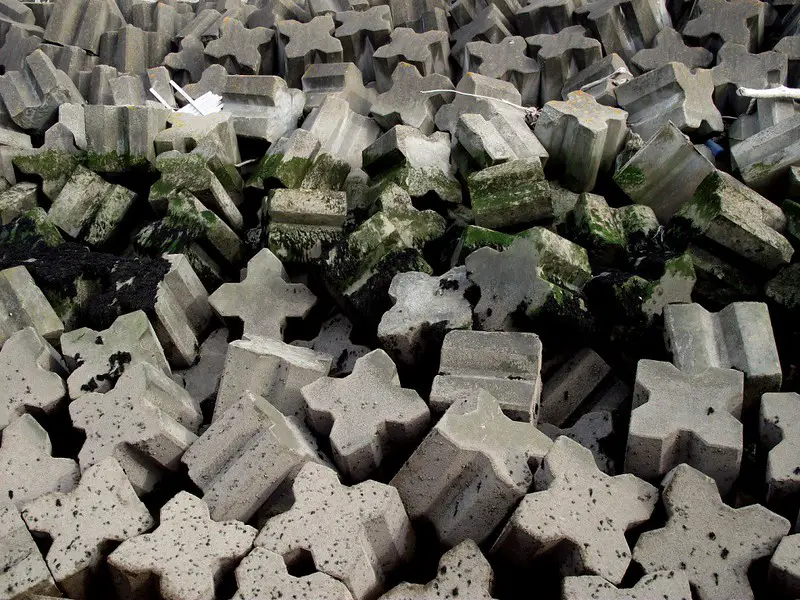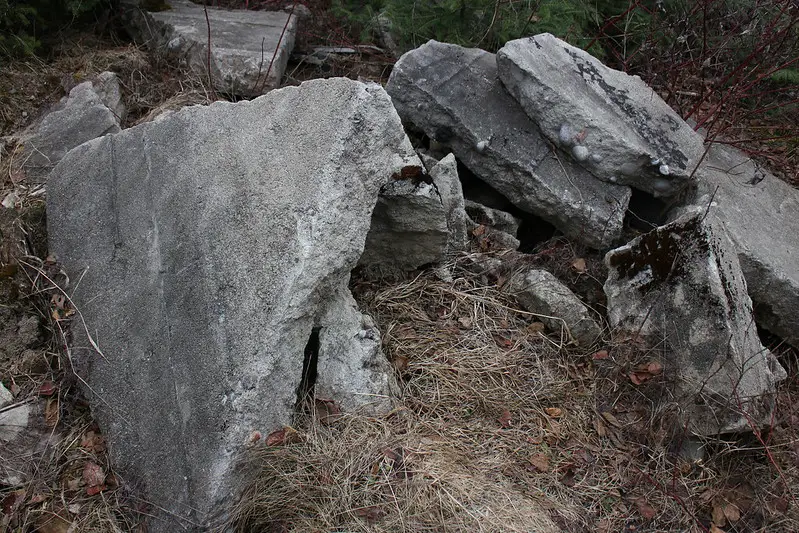Have you ever had an old patio, driveway, or foundation that you wanted to get rid of? Chances are, it was made of concrete. While concrete can be incredibly strong and durable, it can also be a nightmare to get rid of. In the US, approximately 600 million tons of construction and demolition debris are generated each year, which shows how important concrete disposal is.
Concrete is actually a very versatile material. It can be used for a variety of projects, from outdoor patios and walkways to foundations for buildings. But eventually, you may find yourself needing to get rid of old concrete.
Fortunately, there are several ways to safely and efficiently dispose of concrete. In this guide, we’ll discuss the best practices for getting rid of large and small amounts of concrete, including recycling and reuse options.
How To Dispose Of Concrete?
When it comes to disposing of concrete, there are a few different methods you can use, depending on the size and type of concrete that needs to be disposed of. It is important to consider your options carefully and make sure you dispose of the concrete in a safe and eco-friendly way.

1. Rent a dumpster:
If you are looking to dispose of concrete by renting a dumpster, you should first determine how much concrete you need to dispose of and then find the right size dumpster to meet your needs. Generally, a 10-yard dumpster is suitable for disposing of up to 3-4 tons of concrete. If you are disposing of more than this, you should look into a larger dumpster.
Once you have determined the size of dumpster you need, you can contact a local dumpster rental company to arrange for delivery. The rental company will deliver and pick up the dumpster at your location. When filling the dumpster, be sure to keep the weight within the dumpster’s capacity. If the weight exceeds the capacity of the dumpster, the rental company may charge you for the extra weight.
2. Construction and demolition recycling center facility:
Construction and demolition recycling centers are facilities that are dedicated to the recycling of construction and demolition materials, such as concrete. Over 455 million tons of construction and demolition materials were directed for next use. Concrete can be recycled in a variety of ways, from breaking down the material and using it to create new products, to re-purposing the material for use in other applications.
By bringing concrete to a recycling center, it can be processed and reused, rather than taking up valuable landfill space. The landfill space saved can be used for other waste materials, allowing cities and counties to better manage their waste stream.
Additionally, recycled concrete can be used in the construction of new roads, buildings, and other infrastructure projects. This reduces the need for virgin materials and can help to reduce the environmental impact of construction projects. By disposing of concrete in a recycling center, it can be reused, and the environment can benefit from less waste in landfill.
3. Landfills:
Disposing of concrete by landfills is a common method of disposing of concrete waste. This involves taking the concrete waste to a central location where municipal solid waste is dropped off. Depending on where you live, this location may be a transfer station, recycling center, or landfill. If you are looking to dispose of concrete by landfills, you will need to locate the nearest landfill to you. This can typically be done by searching for ‘landfill’ and the name of your city or town.
Once the nearest landfill is located, you will need to make arrangements to take the concrete waste to the landfill. Around 145 million tons of construction disposable material were sent to landfills. So, this tells us that this is one of the most used methods in the world. This is also best for those who have access to a truck or trailer that can transport the concrete waste.
Disposing of concrete by landfills is a cost-effective way to get rid of large amounts of concrete waste. However, it is important to note that landfills are not always equipped to handle concrete waste, so you may need to check with the landfill before you go to make sure they will accept the concrete.
4. Contact a building supplies retailer:
If you need to dispose of your concrete, the best way to do so is to get in touch with a building supplies retailer. Many of these retailers will accept your old and unused concrete for a fee. Depending on the retailer, you may be required to deliver the debris yourself.
When you speak with a building supplies retailer, make sure to provide them with the exact amount and type of concrete you need to dispose of. Some may also charge additional fees for the transportation and disposal of the debris.
If you are unable to transport the debris yourself, some retailers may offer delivery services. However, these services may come with additional fees. Additionally, you should be prepared to provide detailed information about the size and weight of the debris, and the location of the delivery.
5. Contact a landscaping company:
When disposing of concrete, it is best to contact a landscaping company to see if they have any use for the leftover concrete. In addition to sidewalks, flowerbeds, and wall structures, leftover concrete is often used for various projects. In addition, leftover concrete can be used as a base layer for new roads.
To begin the process, reach out to a landscaping company to inquire about concrete disposal. Inform them of the amount of concrete being disposed of and the type of aggregate used. The landscaping company may be interested in the concrete and provide further instructions on how to proceed.
If the company is interested in the concrete, they may ask for the concrete to be delivered to their site. The company may provide their own transportation to have the concrete delivered, or they may ask that you deliver the concrete yourself.
6. Hire a professional junk removal company
Hiring a junk removal professional to dispose of concrete is a great idea. The company will come to the job site, assess the amount of concrete and any other debris present, and provide a free quote for the service. They will then use specialized equipment to break up the concrete and either haul it away or recycle it. This can save time and money by eliminating the need to rent or purchase demolition tools.
Before removing concrete, it must be properly prepared. The area should be cleared of any debris, and any surrounding materials, such as wood, must be covered and protected. The concrete should be broken up into smaller pieces so that it can be lifted and safely transported.
The company often recycles concrete, turning it into reusable materials such as gravel, road base, and stone. This helps reduce waste and can save money in the long run. You can see the junk removal company online also.
7. Donation
Donating concrete is a great way to responsibly dispose of unwanted concrete. By donating concrete, individuals and businesses can reduce the strain on landfill sites, while simultaneously providing an environmentally-friendly solution to getting rid of concrete.
When it comes to donating concrete, the best place to start is by contacting your local recycling center. You can also donate it to some friend or the needy person who is having unfinished work and this leftover concrete can help him/her.
How To Recycle Concrete?
Recycling concrete involves using industrial jaw crushers and massive impactors. In the process of pulverizing the masonry, it is usually passed through a secondary impactor. This helps to separate the dirt from the particles and to distinguish the granular from the fine powder. This material can then be used as a road base, pavement base, and foundation for driveways, as well as for backfilling and shouldering.
Once the concrete has been processed, it can be further recycled to create 2”-3” recycled stone. This process involves milling the concrete pieces into the appropriate size and then sending them through a screening process. This process helps to remove any additional dirt and particles that may be present.
After the 2”-3” recycled stone is produced, it can be used for a variety of projects. This includes drainage systems, pipe bedding, erosion control, and other landscaping projects. It can also be used to create retaining walls and walkways. Additionally, this recycled stone can be used for road and parking lot base material. Recycling of construction and demolition created almost 175,000 jobs in 2016 in the US alone which tells us about the market of recycling.
Recycling concrete is an excellent way to reduce waste and it offers many environmental benefits. It conserves natural resources, saves energy, reduces air and water pollution, and reduces landfill costs. Additionally, it helps to create a sustainable construction industry.
What Type Of Concrete Waste Can Be Reused?

Reusing concrete waste is an eco-friendly way to reduce the need for landfills and save money in construction costs. Concrete waste comes in many forms and can be used for a variety of purposes.
Concrete rubble is one of the most common types of concrete waste. This type of material consists of broken pieces of concrete from construction sites or demolition projects. It can be reused in a variety of ways, such as in the construction of walls and slabs. It is also used for backfilling and for repairing existing concrete.
Concrete blocks are another type of concrete waste. These are typically left over from reinforcing walls and other structures. They can be repurposed for creating new retaining walls and landscaping features.
Concrete mix is yet another type of waste that can be reused. This type of material is made up of cement, sand, and gravel. It is typically used for driveway construction and fence post installation. Concrete mix can also be used for creating pathways, patios, and other outdoor structures.
Crushed concrete is one of the most popular options for reusing concrete waste. This type of concrete is created when the original material is broken into small, uniform pieces. It can be used to fill in low spots and level uneven ground. It is also an ideal material for driveways and pathways as it is much easier to work with than larger stones.
Finally, concrete chunks are yet another kind of a waste to be reused. These are leftover pieces from various construction projects. They can be used for filling in potholes on roads and for preparing roadways for paving.
Things We Can Do With Old Concrete
When it comes to road construction, old concrete can be recycled and used as a base for new roads, parking lots, and driveways. This is a cost-effective and environmentally friendly solution, as it eliminates the need to use new materials. The old concrete can be crushed and reused as aggregate, and the gravel and sand that was originally in it can also be recycled.
Old concrete can also be used as backfill material. Backfill is used to fill in spaces between the walls of a structure, like the spaces between a foundation and a concrete slab. This material provides additional support and helps prevent the structure from settling.
Finally, old concrete can be crushed and used as a shouldered stone. Shoulder stones are placed on the sides of roads or driveways to help protect the edges from wear and tear from vehicles. This material is strong and durable, and it can also be used as a decorative accent.
FAQs
-
What is the best way to dispose of concrete?
The best way to dispose of concrete is to take it to a recycling center that accepts concrete. Many solid waste companies also accept concrete for disposal.
You can also contact your local government to find out what recycling centers or solid waste companies in your area accept concrete for disposal.
-
Are there any environmental considerations when disposing of concrete?
When disposing of concrete, it is important to consider the environmental impacts. Concrete can release dust and other pollutants that can have a negative effect on air quality and water resources.
It is best to use a recycling center or solid waste company that follows environmental guidelines when disposing of concrete.
-
Are there any environmental benefits to using recycled concrete?
Yes, using recycled concrete is more environmentally friendly than using new materials. Recycled concrete reduces waste and also requires less energy to produce.
Additionally, recycled concrete can help reduce air pollution and water pollution caused by the production of new concrete.
-
Can I dispose of concrete in a regular garbage bin?
No, you cannot throw concrete away with regular garbage. Concrete is a heavy material and will take up too much space in a regular garbage bin.
Additionally, it is not suitable for regular garbage disposal, except in small amounts. If you need to dispose of large amounts of concrete, it is best to use any of the above methods according to your need and condition.
-
Where to dump concrete for free?
Local landfill or waste management facilities may offer free concrete dumping for residents. To determine if this is a viable option, inquire about their policies and procedures. Additionally, local construction companies may have information about where to dump concrete for free.
Conclusion
Properly disposing of concrete is an important part of any construction or demolition project. It is important to take the time to understand your local laws, regulations, and practices to ensure the concrete is disposed of safely and responsibly.
Additionally, it is important to consider recycling or reuse options whenever possible to save resources and reduce environmental impacts. With the right plan in place, you can successfully and responsibly dispose of concrete and contribute to a healthier and more sustainable environment.

Gemma Alexander has an M.S. in urban horticulture and a backyard filled with native plants. After working in a genetics laboratory and at a landfill, she now writes about the environment and recycling topics.


